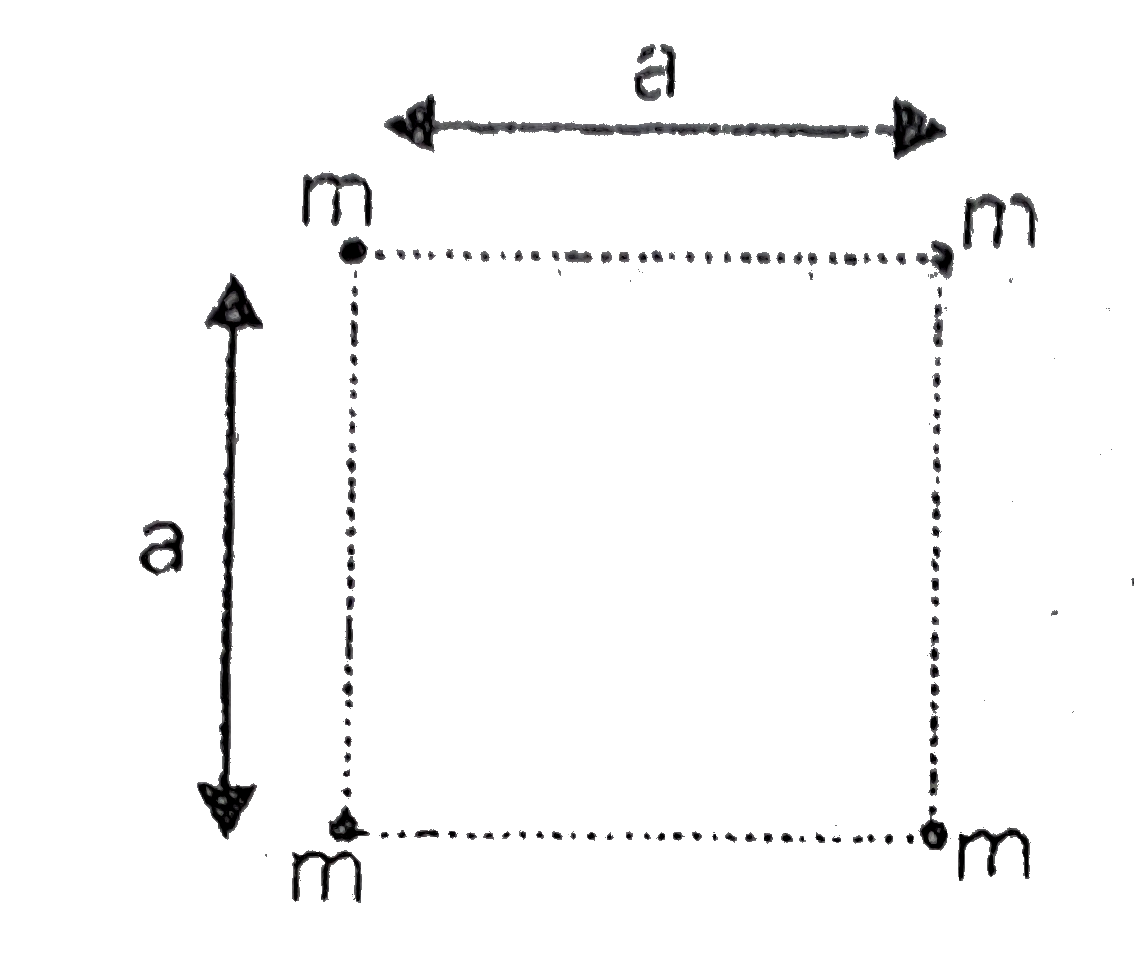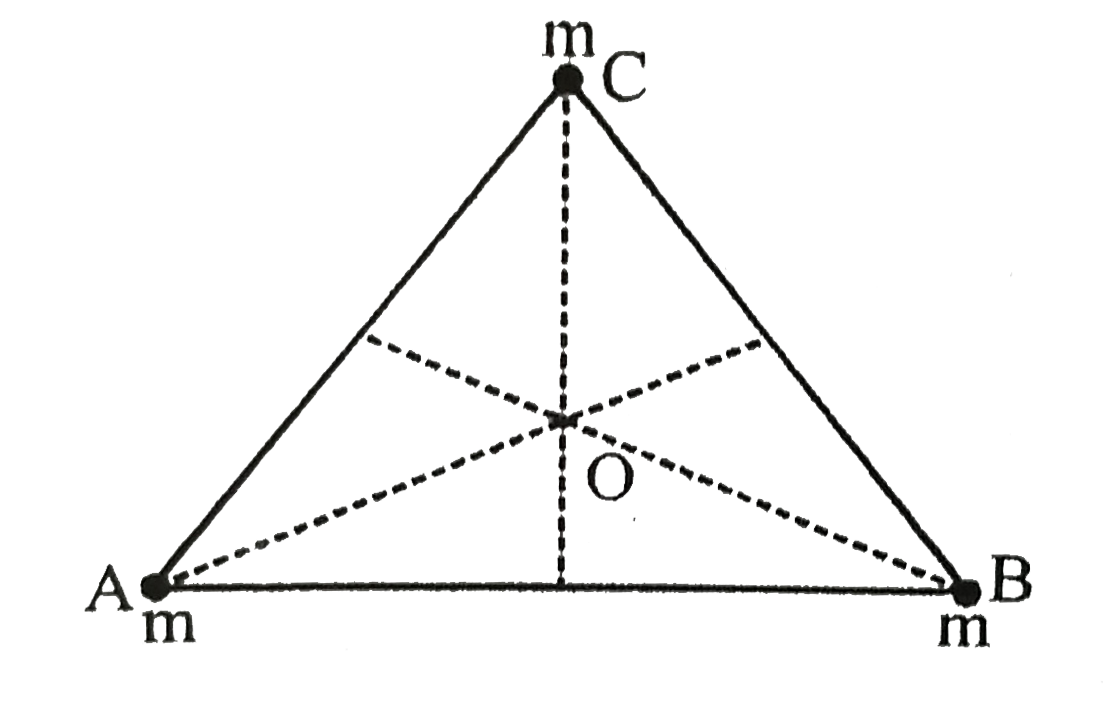Four particles having masses, m, 2m, 3m, and 4m are placed at the four corners of a square of edge a. Find the gravitational force acting on a particle of mass m placed at the centre.
The correct Answer is:A, B, D
To solve the problem of finding the gravitational force acting on a particle of mass m placed at the center of a square with four particles of masses m,2m,3m, and 4m at its corners, we can follow these steps:
Step 1: Identify the Configuration
We have a square with corners labeled as follows:
- Mass m at corner A
- Mass 2m at corner B
- Mass 3m at corner C
- Mass 4m at corner D
The side length of the square is a.
Step 2: Determine the Distance from the Center
The distance from the center of the square to any corner (say point A) can be calculated using the Pythagorean theorem. The distance OA is given by:
OA=a√2
This is true for all corners since they are equidistant from the center.
Step 3: Calculate the Gravitational Forces
The gravitational force F between two masses m1 and m2 separated by a distance r is given by:
F=Gm1m2r2
We will calculate the gravitational force acting on the mass m at the center due to each of the four corner masses.
1. Force due to mass m at A:
FOA=Gm⋅m(a√2)2=Gm2a22=2Gm2a2
2. Force due to mass 2m at B:
FOB=G(2m)⋅m(a√2)2=G(2m)ma22=4Gm2a2
3. Force due to mass 3m at C:
FOC=G(3m)⋅m(a√2)2=G(3m)ma22=6Gm2a2
4. Force due to mass 4m at D:
FOD=G(4m)⋅m(a√2)2=G(4m)ma22=8Gm2a2
Step 4: Determine the Resultant Forces
Next, we need to find the resultant forces along the diagonals of the square.
- Forces FOA and FOC act along diagonal AC.
- Forces FOB and FOD act along diagonal BD.
1. Resultant force along AC:
FAC=FOC−FOA=6Gm2a2−2Gm2a2=4Gm2a2
2. Resultant force along BD:
FBD=FOD−FOB=8Gm2a2−4Gm2a2=4Gm2a2
Step 5: Calculate the Magnitude of the Net Force
Since FAC and FBD are equal and perpendicular to each other, we can use the Pythagorean theorem to find the resultant force F:
F=√F2AC+F2BD=√(4Gm2a2)2+(4Gm2a2)2
=√2(4Gm2a2)2=4Gm2a2√2=4√2Gm2a2
Step 6: Determine the Direction
The direction of the net force will be at a 45-degree angle downward from the center towards the line connecting the corners.
Final Answer
The gravitational force acting on the mass m at the center of the square is:
F=4√2Gm2a2
and it acts at a 45-degree angle towards the corner masses.
We have a square with corners labeled as follows:
- Mass m at corner A
- Mass 2m at corner B
- Mass 3m at corner C
- Mass 4m at corner D
The distance from the center of the square to any corner (say point A) can be calculated using the Pythagorean theorem. The distance OA is given by:
OA=a√2
This is true for all corners since they are equidistant from the center.
The gravitational force F between two masses m1 and m2 separated by a distance r is given by:
F=Gm1m2r2
We will calculate the gravitational force acting on the mass m at the center due to each of the four corner masses.
FOA=Gm⋅m(a√2)2=Gm2a22=2Gm2a2
FOB=G(2m)⋅m(a√2)2=G(2m)ma22=4Gm2a2
FOC=G(3m)⋅m(a√2)2=G(3m)ma22=6Gm2a2
FOD=G(4m)⋅m(a√2)2=G(4m)ma22=8Gm2a2
Next, we need to find the resultant forces along the diagonals of the square.
- Forces FOB and FOD act along diagonal BD.
FAC=FOC−FOA=6Gm2a2−2Gm2a2=4Gm2a2
FBD=FOD−FOB=8Gm2a2−4Gm2a2=4Gm2a2
Since FAC and FBD are equal and perpendicular to each other, we can use the Pythagorean theorem to find the resultant force F:
F=√F2AC+F2BD=√(4Gm2a2)2+(4Gm2a2)2
=√2(4Gm2a2)2=4Gm2a2√2=4√2Gm2a2
The direction of the net force will be at a 45-degree angle downward from the center towards the line connecting the corners.
The gravitational force acting on the mass m at the center of the square is:
F=4√2Gm2a2
and it acts at a 45-degree angle towards the corner masses.
Topper's Solved these Questions
- GRAVITATIONBOOK - DC PANDEY ENGLISHCHAPTER - GRAVITATIONEXERCISE - Exercise 13.2
9 Videos
- GRAVITATIONBOOK - DC PANDEY ENGLISHCHAPTER - GRAVITATIONEXERCISE - Exercise 13.3
5 Videos
- GRAVITATIONBOOK - DC PANDEY ENGLISHCHAPTER - GRAVITATIONEXERCISE - Miscellaneous Examples
8 Videos
- GENERAL PHYSICSBOOK - DC PANDEY ENGLISHCHAPTER - GENERAL PHYSICSEXERCISE - INTEGER_TYPE
2 Videos
- KINEMATICSBOOK - DC PANDEY ENGLISHCHAPTER - KINEMATICSEXERCISE - INTEGER_TYPE
10 Videos
Similar Questions
Four particles having masses, m, 2m, 3m, and 4m are placed at the four corners of a square of edge a. Find the gravitational force acting on a particle of mass m placed at the center.
View SolutionIf four different masses m1,m2,m3 and m4 are placed at the four corners of a square of side a, the resultant gravitational force on a mass m kept at the centre is
View SolutionFour particles of masses m,2m,3m,4m are placed at corners of a square of side 'a' as shown in fig. Find out coordinateds of centre of mass.
View SolutionFour particles of masses 1kg, 2kg, 3kg and 4kg are placed at the four vertices A, B, C and D of a square of side 1m. Find the position of centre of mass of the particles.
View SolutionFour particles of masses 1kg, 2kg, 3kg and 4kg are placed at the four vertices A, B, C and D of a square of side 1m. Find the position of centre of mass of the particles. Assume that D is situated at the origin.
View SolutionFour point masses each of mass 'm' are placed on the corner of square of side 'a' Calculate magnitude of gravitational force experienced each particle
 .
.
View SolutionFour particles each of mass m are kept at the four vertices of a square of side 'a' . Find gravitational potential energy of this system.
View SolutionFour particles of masses 1kg, 2kg, 3kg and 4kg are placed at the four vertices A,B,C and D of a square of side 1m. Find square of distance of their centre of mass from A.
View SolutionThree identical particles each of mass m are placed at the vertices of an equilateral triangle of side a. Fing the force exerted by this system on a particle P of mass m placed at the

(a) the mid point of a side
(b) centre of the triangle
View SolutionFour particles each of mass 'm' are placed at the four vertices of a square 'a' .Find net force on any one the particle.
View Solution
